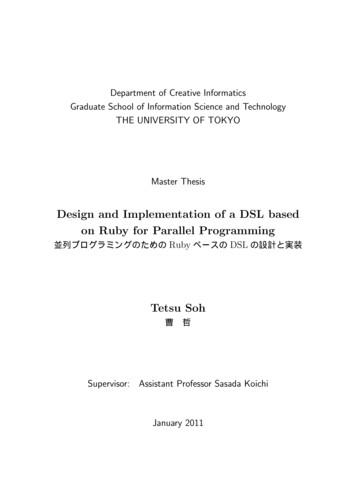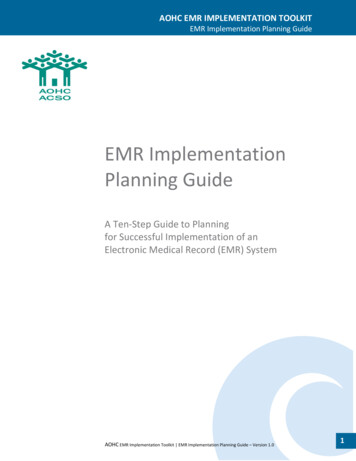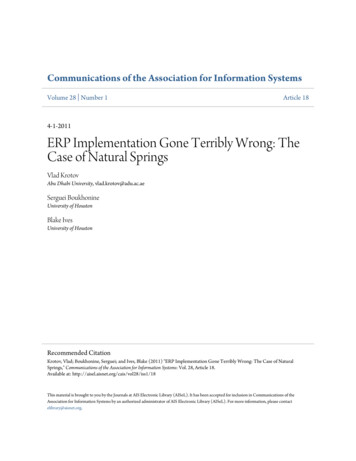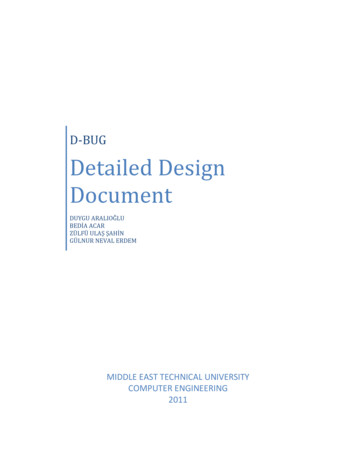
Transcription
Department of Creative InformaticsGraduate School of Information Science and TechnologyTHE UNIVERSITY OF TOKYOMaster ThesisDesign and Implementation of a DSL basedon Ruby for Parallel Programming並列プログラミングのための Ruby ベースの DSL の設計と実装Tetsu Soh曹 哲Supervisor: Assistant Professor Sasada KoichiJanuary 2011
iAbstractFinding a high productivity and high efficient(HPHP) parallel programming languageis a key to achieve popular parallel programming and it has been an active field of researchfor over 3 decades.To achieve HPHP parallel programming language, we proposed to design a DSL basedon Ruby, which is a popular sequential langauge among mainstream developers for itshigh productivity, and then translate the DSL to X10 language, which is a high performance parallel language, to perform parallel execution. Our proposed DSL can expressconcurrent and distributed programming with syntax that is consistent with Ruby. TheDSL code is converted to X10 program by our code translator and is executed in parallelwith some runtime libraries developed by us. The code translator and runtime librariesthat we developed implement most of Ruby’s features and bridge the large gap betweenthe Ruby and X10 language. Therefore, the DSL can keep the productivity of Ruby andachieve high performance. We employ HPC and Ruby benchmarks to evaluate the productivity and scalability of the DSL. The results show that our DSL has better or equalproductivity than the X10 language and similar scalability to the X10 language.
��を達成するための研究が,30 ��言語として知られる Ruby をベースとしたDSL �ミング言語である X10 へと変換する.本研究で設計した DSL は,Ruby のである.この DSL �を用いることで,Ruby とは大きく異なる性質を持つ X10 へと変換する.変換後の X10 ��,Ruby �より,Ruby ��ることができる.HPC,および Ruby のベンチマークを用いて DSL �た結果,提案した DSL は X10 �つ X10 �.
iiiContentsChapter 1Introduction1Chapter 22.12.22.32.4AnylysisParallel ProgrammingOverview of X10 . . .Overview of Ruby . .Goal . . . . . . . . .Chapter 33.13.23.33.43.5Language DesignExample of DSL . . . . . . . .Object Oriented Features . . .Control Structures . . . . . . .Parallel Programming ModuleFeatures Summary . . . . . . .33579.101011181821Chapter 44.14.24.34.4System Design and ImplementationSystem Overview . . . . . . . . .Parsing and AST . . . . . . . . .Converting DSL to X10 . . . . . .Parallel Programming Model . . .2323242532Chapter 55.15.2EvaluationProductivity Evaluation . . . . . . . . . . . . . . . . . . . . . . . . . .Scalability Evaluation . . . . . . . . . . . . . . . . . . . . . . . . . . .333335Chapter 66.16.26.36.46.5DiscussionProductivity of DSL . . . . . . . . . . . . . .Dynamic Typing and Parallel ProgrammingScalability . . . . . . . . . . . . . . . . . . .Parallel Programming Model . . . . . . . . .Hybrid of Ruby and X10 . . . . . . . . . . .Chapter 77.17.27.37.4Related WorkDSL for Parallel Programming . . .Hybrid of Productivity and EfficientRemoving GVL in Ruby . . . . . .Others . . . . . . . . . . . . . . . .Chapter 8ConclusionPublicationsOverview. . . . . . . . . . . . . . . .393939404041. . . . . .Language. . . . . . . . . . .42424243434446
ContentsReferencesiv47
1Chapter 1IntroductionFinding a high productivity and high performance (HPHP) programming language forparallel computing has been an active research field for over 3 decades[1]. The motivation for parallel programming originally comes from scientific programming and highperformance computing (HPC) and most of parallel programming languages are designedfor this purpose. However, recently, as multi-core processors become prevalent and theawareness of crisis for sequential programming [2], mainstream software development isunder the pressure to adapt to parallel programming, which is known as popular parallel programming[3]. One key to achieve the popular parallel programming is parallelprogramming language.On the other hand, people are expecting more for a parallel programming language.The requirement for high performance is just a base line. As the parallel computinghardware becomes various, such as the cluster computers, GPGPU, SMP, people requirethat a parallel programming language should be hardware independent. Moreover, asthere are many different programming algorithms, the language should be not limited toa particular parallel algorithms. So an ideal parallel programming language should behigh productivity, high performance, hardware and parallel algorithms independent.However, we observed that it is very difficult for a programming language to achieve allthese requirements. There are several issues for current parallel programming languages:1. Most parallel programming languages are designed for HPC. Thus, they are verydifficult to use for mainstream programmers. These languages lack productivity.2. Most mainstream programming languages are sequential. They are inadequate forparallel programming because either the language does not support parallel execution, such as Ruby/Python, or lack parallel model to achieve high performance.[4]3. Some languages adopt parallel programming models to achieve parallel programming. For example, the Go language[5] employs Communicating Sequential Processes (CSP) model and the Scala language[6] employs the Actor model. However,these programming models have sharp learning curves because they are every different from the shared memory programming model which programmers are usedto. The result is less productivity.4. Developing new languages has very high implementation cost and it is difficult andtime consuming to make programmers to migrate to a new language and master it.Our proposed solution is to use a source-to-source converter to combine 2 languagestogether to achieve high performance and high productivity. It means that programmerswrite parallel programs in a high productivity language, and then translate the code to ahigh performance language to execute.Our approach is to define a domain specific language (DSL) based on a high productivitylanguage (in this paper the language is Ruby) to express parallel programming model. And
Chapter 1 Introduction2implement the DSL by developing a source-to-source compiler to translate the DSL codeto a high performance language (in this paper the language is X10).Generally speaking, scripting languages are good at productivity and system languagesare good at performance[7]. Ruby[8] is a popular scripting language and is famous forits high productivity. X10[9] is a recently developed HPC parallel language that hascharacters of high performance, hardware and algorithms independence. Therefore, byusing our approach to combine these 2 languages together, we can achieve productivity,performance, hardware and algorithm independence for parallel programming.This approach has several advantages. First, the DSL is based on a mainstream languageso that lots of users can avoid learning a new language to adapt to parallel programming.Second, the DSL can inherit the high productivity from the based language. Third, theimplementation cost is low. By using source-to-source converter, the implementation iseasier than implementing a new language.To achieve our proposed solution, we designed a DSL based on Ruby. The DSL isdesigned to express primitives for parallel programming model in Ruby-style. Thus, userscan write parallel program in Ruby-style. And we developed a converter to translate theDSL code to X10 code. We also developed X10 runtime libraries to implement some ofRuby’s most important features, such as dynamic typing, open class, mix-in and so on.Because there is no Ruby Virtual Machine in the execution of the DSL, so some Rubyfeatures such as dynamic evaluation are not supported.Our research has following contributions: 1) By using the DSL, users can write parallelprogram in Ruby-style. It benefits Ruby users. 2) It benefits HPC users by providingan alternative parallel programming language. The DSL is based on Ruby, so the HPCprogrammers can enjoy the productivity of the Ruby language. 3) The experience ofdeveloping a DSL based on a sequential, mainstream, scripting language for parallel programming can be referred by other developers. DSL seems to be a promising solution forbuilding a parallel language. We put this approach into practice and gain experience onhow to design the DSL and how to solve challenges in implementation.This paper gives an overview of parallel programming models and X10 and Ruby programming languages (chapter 2), the language design of our proposed DSL (chapter 3),the implementation of the language system (chapter 4), the result of evaluation for theDSL (chapter 5) and the discussion (chapter 6). We end with a summary of future work.
3Chapter 2AnylysisIn this chapter, we give an overview of parallel programming. And analyze the pros andcons of the X10 and Ruby programming languages. Through the analysis, we want toclarify following questions. WhyWhyWhyWhyisisisisDSL a possible solution for parallel programming?Ruby inadequate for parallel programming?the DSL based on Ruby?X10 not good for hosting a DSL?Based on the analysis, we define goals and make some design decisions for our proposedDSL.2.1 Parallel Programming OverviewIn this section, we give an overview of parallel programming. It gives a background onparallel programming and clarify some terminologies that will be referred in later partsof this paper.2.1.1 Popular Parallel ProgrammingThe parallel programming originally is mainly used for researches, or academic fields.And the parallel programming languages were almost designed for scientists to performFig. 2.1. Comparison of Parallel Computing Users(Data from Top500.org)
Chapter 2 Anylysis4numerical computing.However, more and more parallel applications are developed in industry fields. Figure2.1 shows the statistics for parallel computing users at year of 1993 and 2010*1 . Fromthese figure we can clearly see the tendency of popular parallel programming, whichmeans to make parallelism pervasive and parallel programming mainstream. To achievethis goal, it requires parallel programming languages that are easy to use for most generalprogrammers. However, current parallel languages are far from this goal.2.1.2 Approach to Parallel ProgrammingFor a language to achieve parallel programming, there are generally 2 approaches: 1) alanguage-based approach, which means to develop a new language from scratch, such asCILK[10], Chapel[11], and X10; 2) library-based approach, which means to implementthe parallel programming model as library to extend existing sequential languages, forexample MPI[12], OpenMP[13]. Because an internal DSL can be treated as a kind oflibrary, so internal DSL is also the second approach to achieve parallel programming.Each approach has its merit and disadvantage. For the language-based approach, theadvantage is that new language can define precise semantics for synchronization constructsand the shared memory model and compiler can do related optimization. The disadvantage is that the development cost is high and it is difficult for users to accept a newlanguage. For library approach, the advantage is that the low learning curves for users.However, the disadvantage is that it is hard to make big breakthrough. The expressivenessand the performance is limited by the hosting language.2.1.3 Parallel Computing EnvironmentsFrom the memory architecture perspective, the parallel computing environments can beclassified as: 1) shared memory system, such as multi-core system, 2) distributed memorysystem, such as cluster system, and 3) hybrid distributed-memory system, such as multicore cluster system, in which each node is a multi-core system.Need to point out that the hybrid distributed-memory system is prevalent recently. Andthis kind of system always requires a hybrid parallel programming model. For parallelcomputing on each node, the shared memory programming model is used, such as Pthreador OpenMP. Parallel execution over nodes is achieved by using distributed memory programming model, such as MPI. Moreover, the merging of hybrid architecture swaps outmost of current parallel programming languages because they cannot provide a hybridprogramming model.2.1.4 Classification of Parallel Programming ModelsThere are many different ways to classify parallel programming models. We classify themodels from abstract level perspective because this effects how we decide to design theDSL. Generally, the parallel programming consists of 4 subtasks[14, 15]:Decomposition Means to find code that can run in parallel and assign them to thread.Mapping Means to specify where the thread should run.Communication Means to send/receive messages among threads.Synchronization Means to manage synchronization among threads.*1The data are provided by Top500.org
Chapter 2 Anylysis5Fig. 2.2. APGAS ModelWe measure the abstract level of a parallel programming language by how many tasks canbe done automatically by the language. More tasks are handled automatically, higher abstract level the language is. For example, the MPI is a very low level parallel programmingmodel because all tasks are handled directly by users.We also know, typically, higher abstract level languages have better productivity because there are less details that need programmers to bother about. However the trade-offis that it is more difficult to achieve good performance. So for a parallel programminglanguage, the balance of abstract level is critical.2.2 Overview of X10X10 is a new developed, statically typed, parallel, distributed, object-oriented programming language designed for HPC[16, 17, 4] . The design goal of X10 is to provide safety,scalability and flexibility for parallel computing. The target of X10 originally is HPCworld, such as scientific applications development. However, recently, it tries to cover thegeneral application development too.2.2.1 Main Features of X10As a new developed language, X10 has some advantages on parallel programming.APGAS ModelThe background of X10 development is the merging of hybrid multi-core cluster computingenvironment as mentioned previously. So the X10 language employs the AsynchronousPartitioned Global Address Space (APGAS) memory model. The figure 2.2 shows whatAPGAS looks like.From the programmers perspective, the PGAS offer a global address space similar toshared memory. It means that it is possible for programmers to create an object thatis visible from any other processes/threads of program. Contrast to MPI on distributedmemory architecture, which is said to has a local address space. An object allocated by
Chapter 2 Anylysis6one process is not visible to others processes. Thus users have to explicitly communicateto other processes to access the object.However, the address space is divided into parts. The access of object crossing partitionis exposed to programmers with special syntax. In such a way, the locality of object isvisible for programmers. Because the cost of memory access to local partition and toremote partition is totally different, the locality-awareness is very important for achieveperformance.To put it together, the APGAS model is suitable for the hybrid cluster of shared memoryarchitecture because it provides the programming convenience of shared memory and thelocality awareness for controlling data layout which is critical to achieve high performanceand scalabilityModest Abstraction LevelAs mentioned in previous section, a parallel programming model/language can be classified by its abstract level. X10 provides automatic communication and synchronization butleaves the decomposition and mapping for programmers to do manually. Because the decomposition and mapping are depended on parallel algorithms and underlying hardware,leaving these tasks to programmers gives the opportunities of manually tunning to maximum performance. The lock manipulation and message sending/receiving can be handledby compiler very well. Therefore, automatically do these tasks will relief programmersfrom onerous tasks and good for productivity.Hardware and Algorithms IndependenceX10 language is design as an general purpose parallel programming language. It can runon different hardwares. It can run on SMP, cluster or CUDA environment. Moreover,X10 does not specify what parallel algorithm should be used. Users can do SPMD or dataparallel with X10.New Programming PrimitivesX10 defined some primitives and built-in objects for concurrent and distributed programming. For concurrent programming, X10 offers the async, finish, atomic and whenprimitives to instead threads and locks. For distribute programming, X10 offers thePlace, Dist, Region and DistArray objects[18].2.2.2 Demerits of X10However, as a parallel programming language designed for HPC, there are disadvantageof X10 that make it less attractive for general purpose programmers.First of all, X10 is less expressive compared to modern dynamic programminglangauges[19]. Because X10’s syntax is consistent with Java, so it has similar expressiveness to Java. For example, users have to close every statement with a semicolon.Moreover, X10 is original designed for HPC programming which is mainly numericaloriented computing. To handle general application development, X10 is less advantage.Second, X10 is a statically typed language. The type system in X10 goes further thanthe type system in Java. X10 has type constrain and generic type. These features arepowerful. However, these features are only make sense to framework developers. Forgeneral programmers they are just make code is hard to read and write. For example, todefine a lambda(function) in X10 looks like:val fun:(int) void (i:int) {// body}
Chapter 2 Anylysis7Compared to do the same thing in Ruby:fun lambda { i #body}Although statical type and dynamic type which is more productivity is still arguable andhard to give a objective conclusion, recently research shows that the type system is notreally as helpful as it seems to be[20]. We believes that modest type system can makecode more understandable and maintainable (type declaration can be used as document),but dynamic type is easier to get hands on.2.3 Overview of RubyRuby is a scripting language and is famous for its ease to use and high productivity. Rubyis always used as “glue” for connecting different components written in other languagesduring software development or to write prototype in early phase of development. However, recently, Ruby is also used to develop some large-scale and long running applications,such as web applications, even enterprise development[21].2.3.1 Main Features of RubyAlthough it is very difficult to clearly define why Ruby is high productivity, there aresome features make Ruby is very easy to use.Dynamic TypingThe variables in Ruby has no compile type. So users don’t need to write the type forvariables. Although statically typed language can benefit from compile-time verificationand better IDE support, dynamic typing make it is easier to start coding – users do notneed to deeply consider and design the interface of a object( such as the type of method).It is especially useful in the early stages of a project because the implementation may bechanged very often.Duck TypingFor static object-oriented language (OOL) the interface of a object is defined throughtype. And users need to confirm the type of an object then can call a method on it. Forexample, in Java, following code is often seen.if (a instanceof String) { // do something on string }In Ruby, users do this by check whether an object has expected method by using respond to? method and if it has the method, then invoke the method usingsend(name) method.This feature reduces the necessary of inheritance. In Java, if you want a class to behaviorlike a String, you have to inherit the String class. In Ruby, you just define methods thata string object should have.Mixins and Singleton MethodsRuby does not support multiple inheritance but it achieves the same effect with mix-in.If a class includes a module, then all methods defined in that module will be mixed intothe class. Users can use the included methods as they as defined on the class.The mix-in is possible because that Ruby allows the dynamic modification of the classat runtime. This character is known as open-class. Singleton method is another feature
Chapter 2 Anylysis8that benefits from the open-class character of Ruby.Singleton method means a method defined on an instance. It breaks the general thinkthat the behavior of an instance is determined by its class. It enables programmers tospecify behavior for a particular instance.Blocks and lambdasThe block/lambda in Ruby is first-class object. Users can treat them as data and passthem among objects. Moreover, Ruby support anonymous lambdas. This features makeit possible to implement block-scoped constructors that look like language features. It isalso one reason that Ruby is good for creating DSL.LiteralsRuby has literals expression for almost every build-in types. Strings, e.g., "string"Numbers, including binary, octal, decimal, hexArrays, e.g., [1,2], %w(each word is element)Hashes, e.g., {key value}Blocks, e.g., {block body}Regular expressions, e.g., /regexp/These literal expressions simplify the creation of new objects.Syntax SugarsRuby defined lots of syntax sugars so that users can use whatever they favor to. Forexample, In X10, users can write a loop structure with either for or while. In Ruby,except while and for, users can also express loop by using loop, until, or each/timesmethods.2.3.2 Demerits of RubyAs a popular mainstream programming language, it is would be very impact if Ruby wasadequate for parallel programming. However, there are some issues for applying Ruby inparallel programming.First of all, Ruby cannot support parallel execution. Ruby do support threads. From CRuby 1.9, the thread model in Ruby is implemented by native thread. So the Ruby codecan run in concurrent. However, due to the use of Giant VM Lock (GVL) in implementation, the Ruby VM cannot support multiple threads to run simultaneously. Ruby VMemploys a mutual exclusion lock to avoid sharing code that is not thread-safe with otherthreads. It means, when a thread in Ruby try to run, it has to first require the GVL.Only after the thread gains the GVL, it can run. The result is that at any time there areonly one thread is running.Second, in shared memory environment, as most mainstream programming language,the concurrent coding in Ruby is achieved by using the thread/lock mechanism. However,the practical development experience tells us that it is very difficult to write correctand efficient parallel program with thread and lock. The thread/lock is too low level.Programmers have to manage the lock and synchronous the threads by themselves. It iseasy to suffer from the dead lock problem or over synchronization that hurt performance.Third, Ruby itself does not support distributed programming. There are some libraries,such as dRuby[22], that implement the distributed programming using technique similar toremote method invocation(RMI). However, the lesson we learned from Java RMI tells thatit is hard to achieve good performance and scalability[23]. Moreover, the basic problem
Chapter 2 Anylysis9with the RMI or RPC techniques is that they does not effective on cluster of multicoresystems.2.4 GoalX10 is a powerful parallel programming language, while Ruby is a easy-to-use sequentialprogramming language. The main goal of our DSL is to bridge the gap between the Rubyand the X10 language to combine the advantages of the 2 languages to achieve parallelprogramming. To achieve the goal, we make following key design decisions.Develop a DSL Based on RubyAs we pointed in previous chapter, to achieve parallel, we can introduce a new languageor implement as libraries(frameworks, DSL) to extends a host language. Because we wantto combine the expressiveness of Ruby and parallel power of X10, a DSL is a promisingapproach. Furthermore, because X10 is less expressive and concise than Ruby, it is notfit to host a DSL. Therefore, we decide to build a DSL on Ruby to use the Ruby syntax.Be Consistent with RubyThe DSL program should looks like original Ruby program. It means that 1)for existingsyntax, the semantics in the DSL should be the same as host language, 2) new introducedsyntaxes should follow Ruby’s conventions, 3) the DSL should implement most of Ruby’smain features.Following the Ruby-style make the converter is more difficult to develop, but we believethat it is convenient for the Ruby users because they need to pay less effort to adapt theDSL.Introduce PGAS ModelBecause Ruby lacks of programming model to address programming challenges on sharedmemory cluster environment, we decide to introduce the PGAS model in our DSL. Thismodel is also used in X10 and other parallel languages, such as UPC[24], and CAF[25],and has been proved to be an effective solution for hybrid memory architecture.Introduce New Primitives for Parallel ProgrammingRuby uses thread and lock to express concurrent program. These primitives are too lowlevel. Thread-based parallelism on shared-memory system has been proved to be a hardway to do parallel. On the other side, X10 has some high level primitives for concurrentprogramming[17]. We decide to express concurrent using high level primitives from X10to instead the thread and lock in Ruby.Moreover, Ruby has not program model for distribute programming but X10 has. Sowe decide to introduce the distributed programming model from X10 into our DSL.Don’t Raise Abstraction LevelConsidering the performance, we decide to keep the abstraction level of parallel programming in our DSL at the same level as X10 language, which means that decomposition andmapping tasks are left to users to handle explicitly.So far, automatic parallelization has not been proven successful except in the scientificfields. Because our main goal is to bridge the Ruby and X10, making a smarter compileris out of this research.
10Chapter 3Language DesignIn this section, we describe language features of the DSL. The DSL combine some featuresfrom Ruby and some features from X10 language. We are aiming at writing parallelprogram in Ruby style. The syntax of DSL is almost consistent with Ruby and most ofRuby features are preseved. So Ruby users won’t feel discomfort with the DSL. However,due to implementation limition, there are some features are not supported in the DSL.3.1 Example of DSLBefore we discuss the design details, in this section, we present 2 example programs toillustrate some of the DSL’s features. Through these programs, we can know what theDSL looks like, how it expresses objected-oriented features and how parallel programmingis handled in the DSL.Concurrent Programming ExampleThe example program 1 calculates the Fibonacci number by using the naive recursivealgorithm. For Ruby users they may be very familiar with the code. Because except for2 statements, other statements are the same as Ruby. However, Ruby users won’t codeFibonacci in the way that we showed here. Generally, Ruby users prefer more functionalprogramming style. To show the DSL’s object-oriented feature, the program uses a moreJava-style.In the program, we define a class named Fib to represent a Fibonacci number. Theclass has a field (instance variable) r to hold the value and a method run to calculate thevalue. In the example, we calculate the Fibonacci 24 and print out the result.In the run method, there are 2 new syntax, finish and async, to achieve calculatingthe Fibonacci value in parallel. The async {block} spawns a new thread to evaluatethe following block and return immediately. So the evaluation of the block is done asynchronously. The finish {block} waits all async evaluations that occur in the block arefinished. In the example, the Fibonacci (N-1) and (N-2) are calculated in two differentthreads. When all calculations are finished, the value Fibonacci N can be calculated.The most important thing demonstrated by this example program is that the DSLachieves concurrent programming while the syntax is consistent with Ruby.Distributed Programming ExampleThe example program 2 shows how to use distributed array to perform 12 22 . . . N 2in parallel. In the DSL, we use Ruby-like syntax to express distributed constructs thatare imported from X10 language. The basic constructs are Point, Region, Dist andDistArray. More details on distributed constructs are explained in later sections.In this program, a distributed array is created and each element in the array is initialized
Chapter 3 Language Design12345678911class Fibattr accessor :rdef initialize(x)@r xenddef runreturn @r if @r 2f1 Fib.new(@r - 1)f2 Fib.new(@r - 2)10finish {async { f1.run }f2.run}@r f1.r f2.r1112131415end1617end1819puts Fib.new(24).runExample 1: Example of Concurrent Programming in DSL12dist Dist.makeBlock(1.1000)dist ary DistArray.new(:int, dist) { pt pt[0] }34sum lambda { x,y x y}56result dist ary.map{ i i*i}.reduce(sum, 0)Example 2: Example of Distributed Programming in DSLto the value that equals to the element’s index. The index of a distributed array isrepresented by the Point object in the DSL. Similar to creating a Ruby Array object, thenew method of DistArray can take a block to perform initialization. Different from RubyArray object, the Dist
an alternative parallel programming language. The DSL is based on Ruby, so the HPC programmers can enjoy the productivity of the Ruby language. 3) The experience of developing a DSL based on a sequential, mainstream, scripting language for parallel pro-gramming can be referred by other developers. DSL seems to be a promising solution for











